

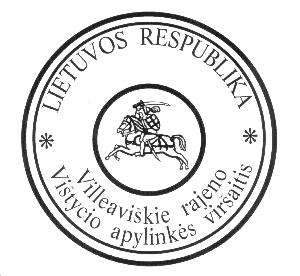
Vishtinetz (Spelled Vistytis in Lithuania today) has changed little in the years since Jacob Rubenstein's autobiography was written. He covered 15 years around the turn of the century. As of April, 1994, there are changes like a few more paved streets, a house or two having an add-on or rebuilt, a new community building on the town square. The town square has a statue of the Grand Duke of Lithuania. On the bottom of the statue, on four sides, there is a bronze plaque of the President of Lithuania for the period between the First and Second World Wars when Lithuania was self governed. (Click here to see a map.)
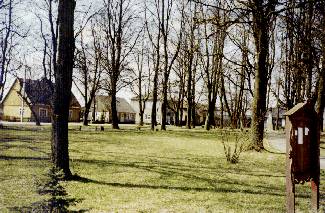
The major change, of course, is that Vishtinetz is now under Lithuanian rule. Not the Prussians, nor the Russians, Germans, or Polish rule. They have seen an erosion of population, and no Jewish citizens, who at one time numbered almost 1,500. The town hasn't changed much. I had few surprises when I drove into town. I felt that I had read the book and now I was seeing the movie.
There are no stores on the square, no farmers markets on weekends or weekdays, no more water wells in the square, and, of course, no synagogues or mikvah. There were no pig-bristle factories; I would imagine that even Nylon is used in todays brushes. I was told that until ten years ago pig-bristle brushes were in use, even pig-bristle tooth brushes. There are a few old military barracks around that are not in use. The only sight of any military is the guards at the border crossings.
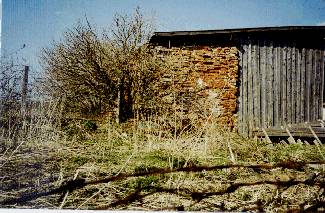
The most exciting part of the square was the Rubenstein house and others still intact. It was structured with a common wall to the Abraham Shimelson home. There is no doubt in that the home was positioned on the northwest corner of the square. This was described by Jacob Rubenstein's autobiography. The home was rebuilt after the fire in 1901. The Shimelson home on the corner is within 100 yards from the German (now the Russian) border and the Moses Arnsdorf home. The Arnsdorf home is no longer a store but a residence.
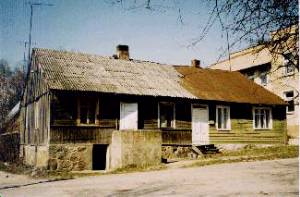
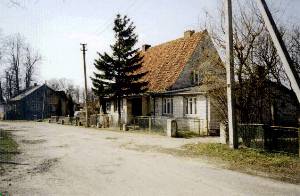
The red brick home on the northeast corner, being the home of Mordecai Meir Linde, still stands. The portion used as a liquor store is now the clinic, and a family now lives upstairs instead of Polish bachelor soldiers. I visited some of the older citizens, but little was gained in that they were not alive when our family lived there. Some vaguely remembered the names that I mentioned and some seemed to remember the names as mentioned by their parents, but nothing specific. The Jewish population did not mingle, due to the language barrier -- all Jews spoke Yiddish. There was also the difference of culture. It is understandable that the memory of the names didn't ring a bell. The Post Office is still on the corner, but it has a new brick face and the second floor is now the Town Hall. One of the first two telephones in town of course is still in the post office, but I found that most of the homes now have a telephone.
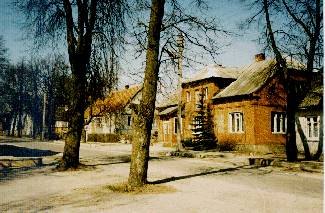
The old cemetery is totally gone, either by weather or stones being taken for local construction. Before the war there was a stone wall surrounding the cemetery, but the Germans sold most of the stone to local people. The newer cemetery is still on the border, and now Russia, and can be touched by walking to the edge of the cemetery, which I did. During a funeral when activity was going on a young person could sneak into the forest, which is quite dense, and keep going into the next country, Germany when our family lived there. At one time the border went through the center of the cemetery and the lake. The lake is still split, but now between Lithuania and Russia.
The road to Virbalen is now paved, and the street around the town square is not cobblestone but cement. The creek was running strong as it was spring, but crossing is not the problem of the past. Even though the same type of wagons are still in use, they can now use the bridge and avoid being stuck in the mud. The old walking bridge is gone, replaced by a large round pipe covered with dirt, to make crossing the creek no problem.
The road to Virbalen takes about 30 minutes instead of half a day by wagon. The road crossing the border into Russia from Vishtinetz is paved and a trip to Kaliningrad would take but a few hours, instead of days. The only other road entering Vistytis is dirt and hard to travel due to ruts, dust and boulders. Virbalen has stores and bars on the main street. I visited the grocery store to find bottled water, but to no avail. I didn't want to take the chance of drinking the water, so I drank cokes. We were able to get quart bottles of cola. We were unable, however, to get paper cups. I purchased a set of cheap pottery cups which did the job. Soft drinks were in abundance along with fruit; I ate lots of bananas. I used cokes to brush my teeth with tooth paste. This is quite a trick in that coke and tooth paste results in lots of foam.
Virbalen is somewhat larger than Vishtinetz, in that it has the railroad as an asset. The tracks run between Berlin, Germany and St. Petersberg, Russia, shipping both passengers and produce in and out of the area. Virbalen is one of the two major factors accounting for the shrinking population of all small towns in the area. The other factor is the Jews not returning or killed during the Second World War.
The synagogue is not intact, but the wall of the oldest one still stands. The second synagogue and the Jewish school next to it were nowhere to be seen. I was able to see the inside of the barn, and could visualize a service being held in the 1800's. The wall existed for the Torahs and above the wall a faint outline of a Star of David on a fixture was visible. What a shame that Vishtinetz is reduced to a little hamlet with no importance to the outside world. When the Jews were in Vishtinetz the community had bakeries, tanneries, mills, hat, glove, shoe and pig-bristle factories. The town was producing and supporting itself.
There were only 650 people living in town in 1994, compared with approximately 3,000 at the peak of the shtetl's prosperity. There are no restaurants or other businesses in town that I could see. There is a cafeteria that is used by the school and townspeople. No Jews live in Vishtinetz now, and probably not since the Second World War.
The only income in town has to come from farming. The land is fertile and some fields were planted and some were being plowed. There is one subtle difference in the farming approach; besides the outdated equipment, there are no houses on the farms. All of the farmers live in town. I noticed a few two-story homes that had been recently built, all exactly alike. The older houses were also alike with few exceptions. The two-story homes were on the square, and I am sure they are owned by the wealthier citizens.
The animal situation has changed since our ancestors lived in Vishtinetz. I didn't see any pigs or chickens in the yards. No cows in any pasture to be seen. Our ancestors seemed to all have a cow. Horses were used for transportation, but most families have an old car or used the bus for travel.
Some horses were seen pulling farm wagons. I'm sure that some horses are still used for plowing on the small poorer farms, but I didn't see any. The horses that I did see were pulling wagons. The farmers still use this means to bring their crops to town. Being spring, the grass and weeds were green and a spring flower appeared here and there. I noticed a pretty little blue wild flower throughout the cemeteries.
The major "attraction" in town is the result of the Holocaust. When the Germans arrived in town, so the story on the plaque reads, "They killed 222 Jews". The men were taken to the windmill and forced to dig their graves, were shot, and buried. The women and children were killed later in the forest and buried. The plaque mentioned "helpers" meaning the Lithuanians, but does not mention them as Lithuanians. Two years later the locals dug the buried Jews and placed them back together as families. I talked (through an interpreter) to an 85 year old woman, Mrs. Domicele Cerniauskiene who claimed to be one of those who helped dig and re-bury the bodies. I didn't ask, but it seems that it would be very difficult to identify the families after two years especially when the Germans were still occupying the city. In my readings there is some doubt that men only were killed at the mill.
The stones in the cemeteries were desecrated in the newer cemetery, but some were still intact and we found three Oppenheim stones. I am sure they are our family, but I'm still not clear where they fit. The one that seems most possible is Rachiel Leah daughter of Chiam Oppenheim who could be the son of Baruch's that did not immigrate. The second stone was that of Itzchak son of Tzvi Oppenheim. This stone also read "Dearest Father, man born of honest charitable and righteous, buried here, bless his soul". The third stone was that of Sarah Beila, who was buried by her father Oppenheim. This stone was quite weathered and hard to read. The remainder of the Hebrew was not legible. In 1993, the Lithuanian towns people erected a stone plaque commemorating the Jewish citizens who once lived in Vishtinetz.
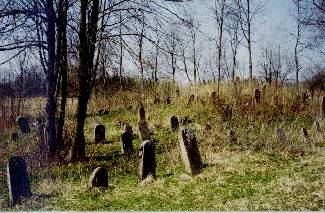
The older cemetery on the hill closer to town was totally destroyed. The land is protected against other uses, such as farming or buildings. We would have missed the oldest cemetery altogether if it hadn't been for a farmer who happened by and talked to us. He pointed out the older cemetery and we proceeded to walk the hill. There were remnants of headstones with small Hebrew writings, but not enough to make out. I did wonder if these could be Baruch, or Soloman, or Benjamin, or Samuel, or one of the wives; we will never know. After traveling around Europe and the United States, ending my travels in Vishtinetz, Lithuania was special. I found myself praying as I was thinking of our ancestors. I wish I could have gotten to know them. A few conversations could have certainly straightened out the many puzzles regarding our ancestors. I felt a special feeling being among my distant relatives and wondering what they were like. What a wonderful time we would have had talking and listening to each other for a few hours. I left with many feelings about Vistytis, but the strongest is that if this area was in America it would be a top resort. The lake, hills, and lush forests create a beautiful landscape.